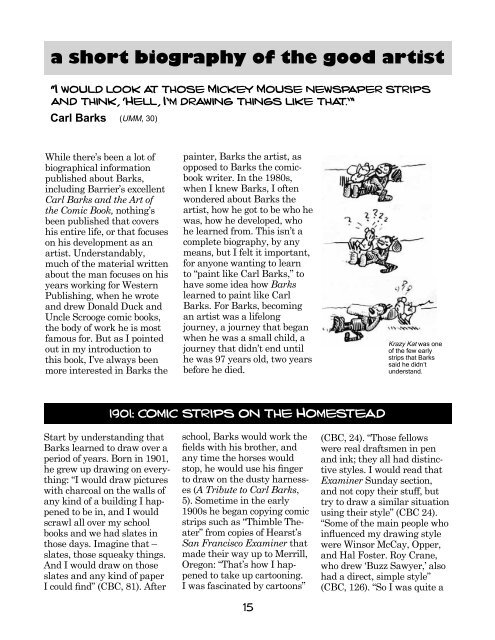Painting Fine-Art Cartoons in Oils - Enchanted Images
Painting Fine-Art Cartoons in Oils - Enchanted Images
Painting Fine-Art Cartoons in Oils - Enchanted Images
You also want an ePaper? Increase the reach of your titles
YUMPU automatically turns print PDFs into web optimized ePapers that Google loves.
a short biography of the good artist<br />
“I would look at those Mickey Mouse newspaper strips<br />
and th<strong>in</strong>k, ‘Hell, I’m draw<strong>in</strong>g th<strong>in</strong>gs like that.’”<br />
Carl Barks<br />
(UMM, 30)<br />
While there’s been a lot of<br />
biographical <strong>in</strong>formation<br />
published about Barks,<br />
<strong>in</strong>clud<strong>in</strong>g Barrier’s excellent<br />
Carl Barks and the <strong>Art</strong> of<br />
the Comic Book, noth<strong>in</strong>g’s<br />
been published that covers<br />
his entire life, or that focuses<br />
on his development as an<br />
artist. Understandably,<br />
much of the material written<br />
about the man focuses on his<br />
years work<strong>in</strong>g for Western<br />
Publish<strong>in</strong>g, when he wrote<br />
and drew Donald Duck and<br />
Uncle Scrooge comic books,<br />
the body of work he is most<br />
famous for. But as I po<strong>in</strong>ted<br />
out <strong>in</strong> my <strong>in</strong>troduction to<br />
this book, I’ve always been<br />
more <strong>in</strong>terested <strong>in</strong> Barks the<br />
Start by understand<strong>in</strong>g that<br />
Barks learned to draw over a<br />
period of years. Born <strong>in</strong> 1901,<br />
he grew up draw<strong>in</strong>g on everyth<strong>in</strong>g:<br />
“I would draw pictures<br />
with charcoal on the walls of<br />
any k<strong>in</strong>d of a build<strong>in</strong>g I happened<br />
to be <strong>in</strong>, and I would<br />
scrawl all over my school<br />
books and we had slates <strong>in</strong><br />
those days. Imag<strong>in</strong>e that –<br />
slates, those squeaky th<strong>in</strong>gs.<br />
And I would draw on those<br />
slates and any k<strong>in</strong>d of paper<br />
I could f<strong>in</strong>d” (CBC, 81). After<br />
pa<strong>in</strong>ter, Barks the artist, as<br />
opposed to Barks the comicbook<br />
writer. In the 1980s,<br />
when I knew Barks, I often<br />
wondered about Barks the<br />
artist, how he got to be who he<br />
was, how he developed, who<br />
he learned from. This isn’t a<br />
complete biography, by any<br />
means, but I felt it important,<br />
for anyone want<strong>in</strong>g to learn<br />
to “pa<strong>in</strong>t like Carl Barks,” to<br />
have some idea how Barks<br />
learned to pa<strong>in</strong>t like Carl<br />
Barks. For Barks, becom<strong>in</strong>g<br />
an artist was a lifelong<br />
journey, a journey that began<br />
when he was a small child, a<br />
journey that didn’t end until<br />
he was 97 years old, two years<br />
before he died.<br />
1901: comic strips on the Homestead<br />
school, Barks would work the<br />
fields with his brother, and<br />
any time the horses would<br />
stop, he would use his f<strong>in</strong>ger<br />
to draw on the dusty harnesses<br />
(A Tribute to Carl Barks,<br />
5). Sometime <strong>in</strong> the early<br />
1900s he began copy<strong>in</strong>g comic<br />
strips such as “Thimble Theater”<br />
from copies of Hearst’s<br />
San Francisco Exam<strong>in</strong>er that<br />
made their way up to Merrill,<br />
Oregon: “That’s how I happened<br />
to take up cartoon<strong>in</strong>g.<br />
I was fasc<strong>in</strong>ated by cartoons”<br />
15<br />
Krazy Kat was one<br />
of the few early<br />
strips that Barks<br />
said he didn’t<br />
understand.<br />
(CBC, 24). “Those fellows<br />
were real draftsmen <strong>in</strong> pen<br />
and <strong>in</strong>k; they all had dist<strong>in</strong>ctive<br />
styles. I would read that<br />
Exam<strong>in</strong>er Sunday section,<br />
and not copy their stuff, but<br />
try to draw a similar situation<br />
us<strong>in</strong>g their style” (CBC 24).<br />
“Some of the ma<strong>in</strong> people who<br />
<strong>in</strong>fluenced my draw<strong>in</strong>g style<br />
were W<strong>in</strong>sor McCay, Opper,<br />
and Hal Foster. Roy Crane,<br />
who drew ‘Buzz Sawyer,’ also<br />
had a direct, simple style”<br />
(CBC, 126). “So I was quite a


